
Handling Complaints Effectively In Your Beauty Salon
While you can't avoid complaints from clients altogether, you can learn how to deal with them effectively. We'll help you successfully handle any objection that might come your way and create a satisfied clientele.
 Nikolina
NikolinaNobody likes getting complaints from clients. Still, they are a frequent occurrence in the beauty industry, which is why you have to learn how to deal with them effectively.
In fact, you can look at them as a learning experience to make the services you provide even better. We’ll teach you how.
In this text, we bring you ten tips you can incorporate into your salon policy to build a better relationship with your clients, even after they come to you with their concerns. When you successfully resolve a complaint, you’ll see that you can get a loyal customer for life.
Make Sure the Complaint Is Genuine
Before you invest your time and energy in handling a complaint, you should first inspect whether it is genuine.
Good client relationships are sacred in beauty salons. After receiving a complaint, your first instinct may be to jump to finding the solution because you want to make your clients happy.
After all, considering that out of 26 unhappy customers, only 1 will complain at all, you want to take the complaints you do receive seriously.
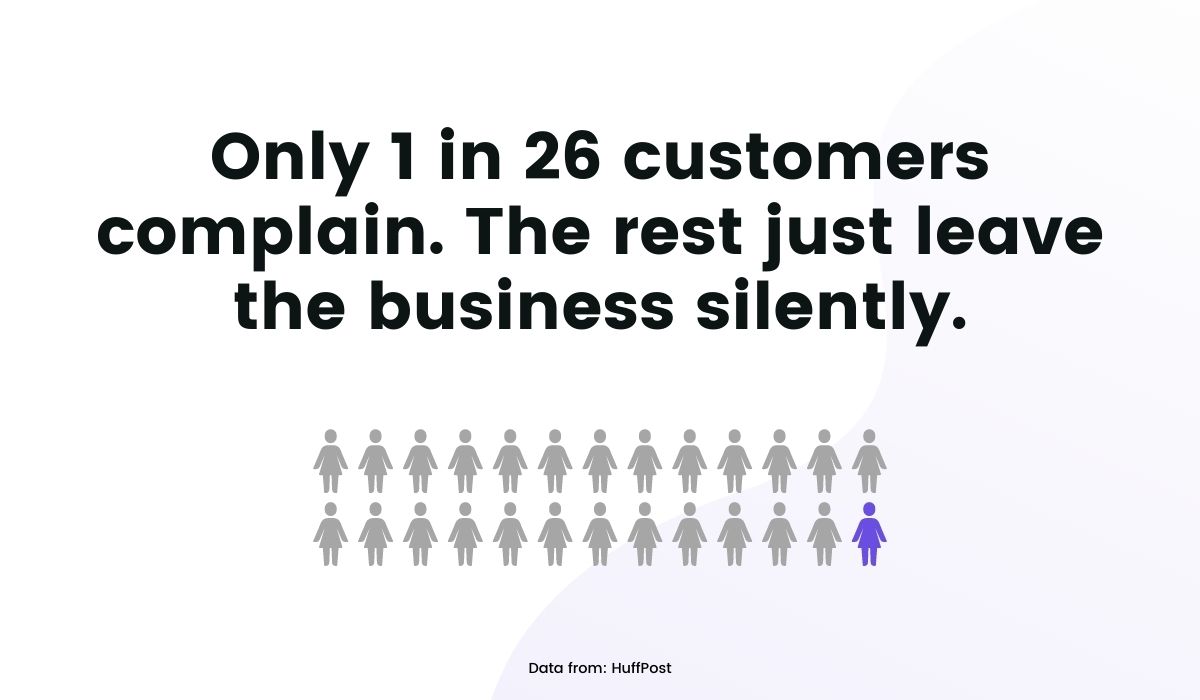
Source: Zoyya
However, by acting with urgency, you may be getting ahead of yourself. Your first step should be to examine the authenticity of the complaint.
Receiving a complaint about, for instance, a beautician operating without their license is completely valid, and it shows an oversight on your part. However, complaints usually tend to be less severe, along the lines of gel nail polish wearing off too quickly.
When you receive such a complaint, before refunding the client, ask them to return to the salon so you can inspect the quality of the work for yourself. If the client turns out to have been washing the dishes constantly without gloves, the worn-out manicure is hardly your fault.
There will always be those clients who try to complain about tiny details in hopes of getting another free treatment.
So, as a salon manager, it’s your responsibility to determine whether a complaint is valid and avoid wasting your resources on unfounded ones.
Be Calm and Listen
Regardless of the nature of the complaint, a good salon manager will always calmly listen to what the client has to say.
The process of voicing a complaint is not easy for anybody involved. Expressing dissatisfaction with the service inevitably stirs up some negative emotions.
So, when a client gets upset, you have to keep your cool and stay professional. Even if you think they’re in the wrong, let them talk freely.
Keep in mind that, when clients raise their concerns, you should dedicate your time and attention only to them. It’s a good idea to step away from other clients and staff at that moment, to signal to the client that they have a safe space to speak.
At this point, it’s important to refrain from offering any explanations or excuses. Allow your clients to clearly state their complaints without interrupting them.
Such an attitude makes them feel heard, which was what they really wanted in the first place. To amplify that, once they are finished, do your best to summarize their concerns in your own words to show you’ve understood.
Here’s an overview of the steps you can take to acknowledge the client who has come forward with a complaint.
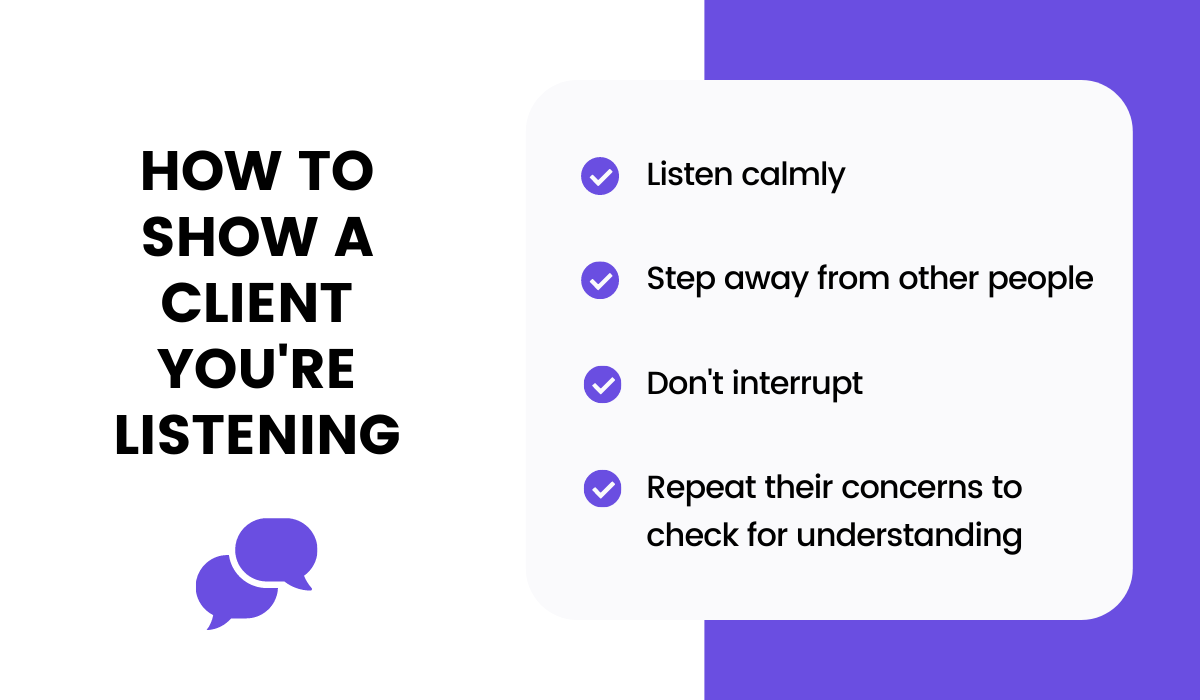
Source: Zoyya
Receiving complaints productively boils down to good listening skills. Treating your clients with respect creates a way for you to find the best solution together.
Find the Underlying Reason for the Complaint
When handling complaints in your salon, you should scratch below the surface and find the underlying reasons for your clients’ dissatisfaction instead. That will allow you to deal with the source of the problem, not its symptoms.
In a spa or a beauty salon, clients can focus too much on the details as they voice their complaints, when what really bothers them remains only implied.
For instance, a survey on customer complaints revealed that it isn’t the quality of service or products that primarily motivates customers to complain; it’s the way employees interact with them.
On the following graph, you can see the most frequent reasons for the customers’ complaints.
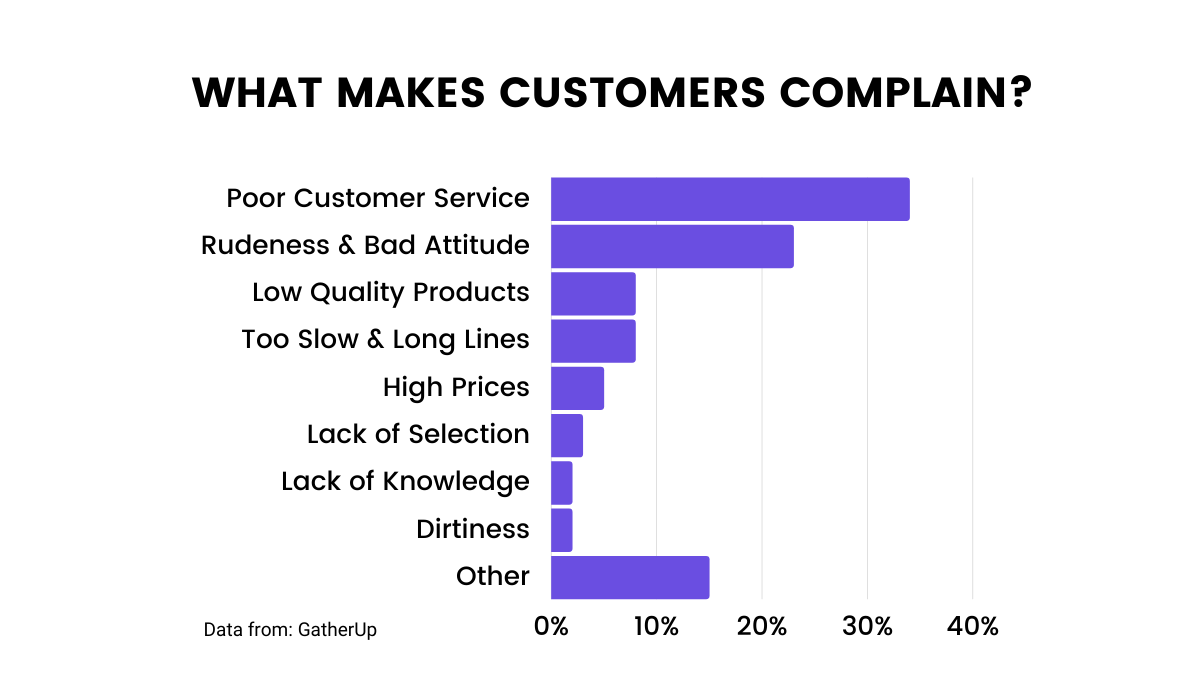
Source: Zoyya
These general reasons can be manifested in various specific forms.
For example, if you receive several complaints on lash extensions done by the same esthetician, the reason for your clients’ dissatisfaction may not be your salon as a whole, not even your lash extension service.
Instead, the clients may simply be unhappy with that one beautician’s practices.
Identifying the underlying reason helps you tackle the issue directly. Rather than handling each complaint individually, getting to the bottom of the problem enables you to prevent similar complaints in the future.
To do that, you’ll have to make sure what the situation on the ground is like.
To return to our example, the one with clients complaining about a particular esthetician’s work, what you should do is spend a day with them, see where the problem lies, and then provide specific guidelines on how they should improve their work.
That way, you’ll be preventing all future complaints from occurring in the first place.
Support Your Team
Although you’ve heard that the customer is always right a million times, sometimes the best way to resolve a problem is to stand behind your team instead of assuming that the cliche is true.
Having a manager’s support makes employees more confident, reducing the number of mistakes they make and consequently the number of complaints your salon receives.
That doesn’t automatically mean that you should ignore your employees’ oversights. Instead, hold them accountable for their work, but make sure you listen to their side of the story as well.
Did you know that adopting such an approach can also increase the workers’ job satisfaction? According to a Gallup survey, 59% of millennial employees whose managers hold them accountable for their performance want to keep working in their current positions.
Therefore, when handling salon complaints, it is important to get the whole story. Listen to the client, but also find out what the beautician who performed the problematic service has to say.
After all, they are the expert, not the client. Ask them which products, tools, and equipment they’ve used and for how long, so you can form an objective opinion.
If you show your team you trust them, they’ll feel comfortable coming forward even when they make a mistake. Your employees will know you have their back.
Not having to tiptoe around the clients will also make them more self-assured, and 98% of workers say they perform better when they feel confident.
Keep Records of Your Clients’ Complaints
The most efficient way to handle complaints is to draw on your previous experience with similar situations. You can do that by keeping a base of prior complaints, the content of the complaints, and the solutions you came up with.
The reasons many beauty salons are turning to booking apps are numerous: less time spent on administrative tasks, easy scheduling, tracking the most popular services, and sending automatic reminders.
But one of their less obvious, yet invaluable benefits of a well-designed booking app is that you can use it to deal with complaints more efficiently.
For instance, Zoyya lets you build a customer base where you can also enter your clients’ complaints and make a note of the steps you’ve taken to resolve them.
Since one of Zoyya’s features is creating business reports, you can also use that tool to see if there are any trends in complaints.

Source: Zoyya
Why would you go back to handling each complaint individually when you can track complaints and make informed decisions based on the data you’ve entered?
A good appointment booking app can transform the way you run the business; you just have to know how to use it. For instance, you can check out how the Kynsi beauty salon improved the customer experience with Zoyya here.
Try to Resolve the Issue Quickly
Sitting on a complaint instead of dealing with it can deter clients from returning to your business, which is why you should aim to resolve all the issues as they appear.
The Harvard Business Review has analyzed the data on customer complaints from five major airlines and found that those clients whose issues get resolved quickly become not only returning customers but also show a willingness to pay more for future services.
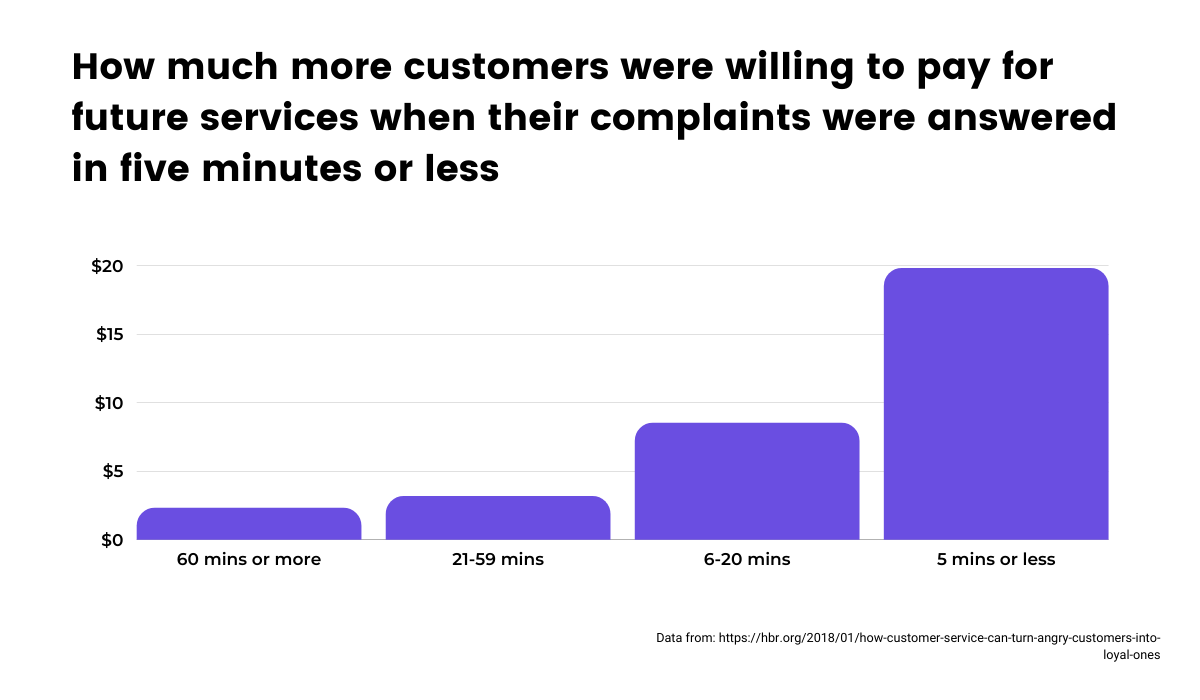
Source: Zoyya
While you’re not running an airline, you still want your customers to return to your salon even after they’ve voiced a complaint. Guided by the principle described by Harvard experts, you should act quickly when it comes to resolving complaints.
Responding to your clients’ complaints without delay shows them you care about them and their satisfaction. After all, they are essential to your business, and you should treat them that way.
Still, you won’t always be able to resolve an issue as soon as it comes up. Nevertheless, what you can and should do instantly is acknowledge it.
By letting the client know you’ve received their complaint, you’re making them feel seen, and letting them know they can rely on you to resolve the issue as soon as you are able to give them your undivided attention.
Do the Treatment Again Instead of Refunding
If you want to improve the relationship with an unhappy client and keep them coming back to your salon, you should always choose to redo a treatment instead of offering a refund.
This way, the client gets to see the improved results for themselves.
Offering to give the client their money back may be tempting because it displays your confidence in your abilities. Beauticians who offer refunds often operate under the impression they will never need them because every client will get the desired results.
However, in the beauty industry, not everything always goes according to plan.
Let’s say the client books an appointment and arrives as scheduled, only for you to realize their hairs are too light for an IPL hair treatment or nails too damaged for acrylics.
However, the client insists you do the treatment, and a week later, they call you complaining they aren’t satisfied with the results.
You are now faced with two choices of remedying the situation: refunding the client or redoing the treatment.
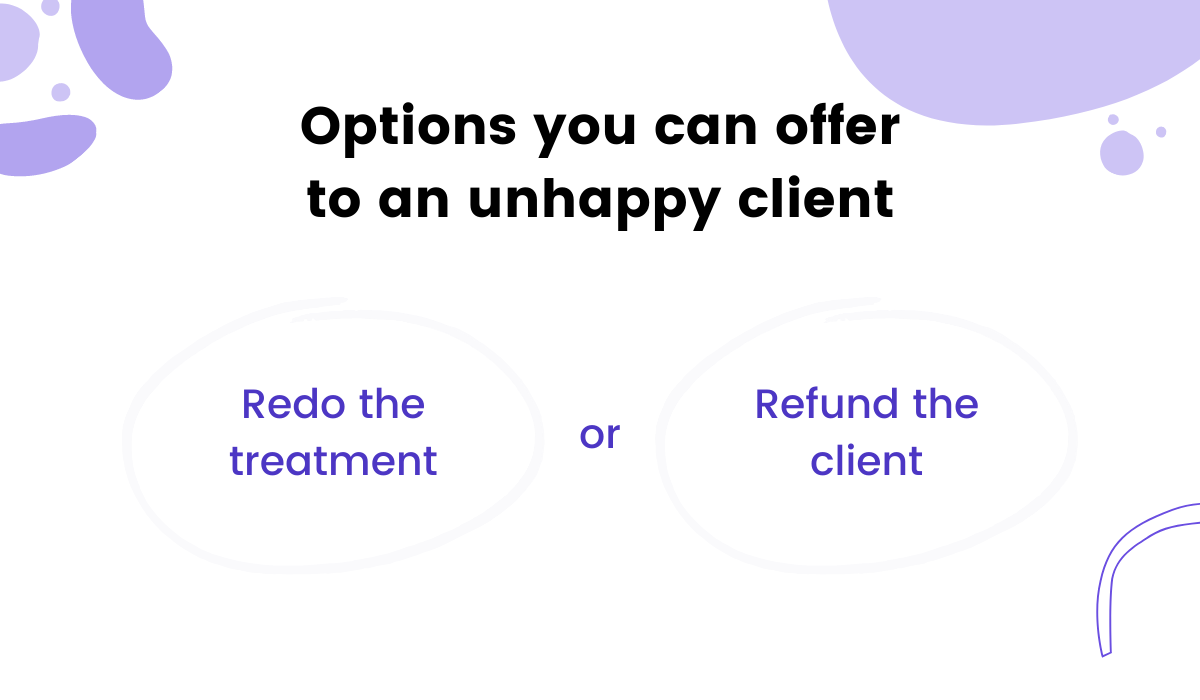
Source: Zoyya
If you refund the unhappy client, chances are they will never return. They will spend that money on getting the same treatment elsewhere while telling everyone about their negative experience with you.
However, if you offer to redo the treatment or suggest another, more suitable treatment with similar results, you get another chance to show the client what you can do.
By redoing the treatment, you also show your clients you only accept the best results from your staff—a client leaving your salon unhappy is not an option.
Respond to Online Complaints
Just as a client telling their friends about an unsatisfactory experience they had at your salon can damage your reputation, so can negative online reviews. Therefore, you should respond to them in a timely and effective manner, and let other clients see your professionalism.
Today’s customers have high standards and are careful about where to spend their money and time. Because of this, 76% of customers look up a company online before visiting the location.
In their research, they rely heavily on reviews.
Since there will always be some negative reviews, you have to know how to deal with them.
Below, you can see a great example of handling a complaint.
The business owner first thanked the client for the review and then proceeded to ask for details to find the source of the problem. The response also included an explanation of the salon’s manicure treatments.

Source: Google
The salon owner also didn’t try to shift the blame or prove to the client they were in the wrong.
Instead, they politely described the treatments they offer and asked for details on the client’s dissatisfaction with the service.
With such an approach, receiving online complaints is nothing to be afraid of. In fact, they can be good for your business. Clients find 5-star ratings too good to be true, so they find salons with a few negative ratings more authentic.
In fact, eighty-five percent of consumers seek out negative reviews because they’re looking for transparency.
However, be careful not to enter any arguments with clients online. They are better dealt with in private.
Write a Complaints Procedure/Policy
No salon owner hopes they’ll have to enforce a complaints policy, but the need arises sooner or later. By preparing a clear policy, you’ll be ready to deal with any complaints that come your way effectively.
Your complaints policy should include the following information:
- Who can make a complaint
- A time frame for a complaint
- How a complaint can be made
- The complaints process
Requiring clients to follow the timeframe set in the policy puts a stop to awkward situations, such as when a client returns to your salon a month after waxing complaining that the treatment wasn’t done properly.
Some salons only allow clients to make complaints immediately after the treatment while the beautician who performed the treatment is present to fix the mistakes. You have to find an appropriate timeframe for complaints depending on the services you provide.
The complaints policy should also clearly describe the ways for the client to make a complaint.
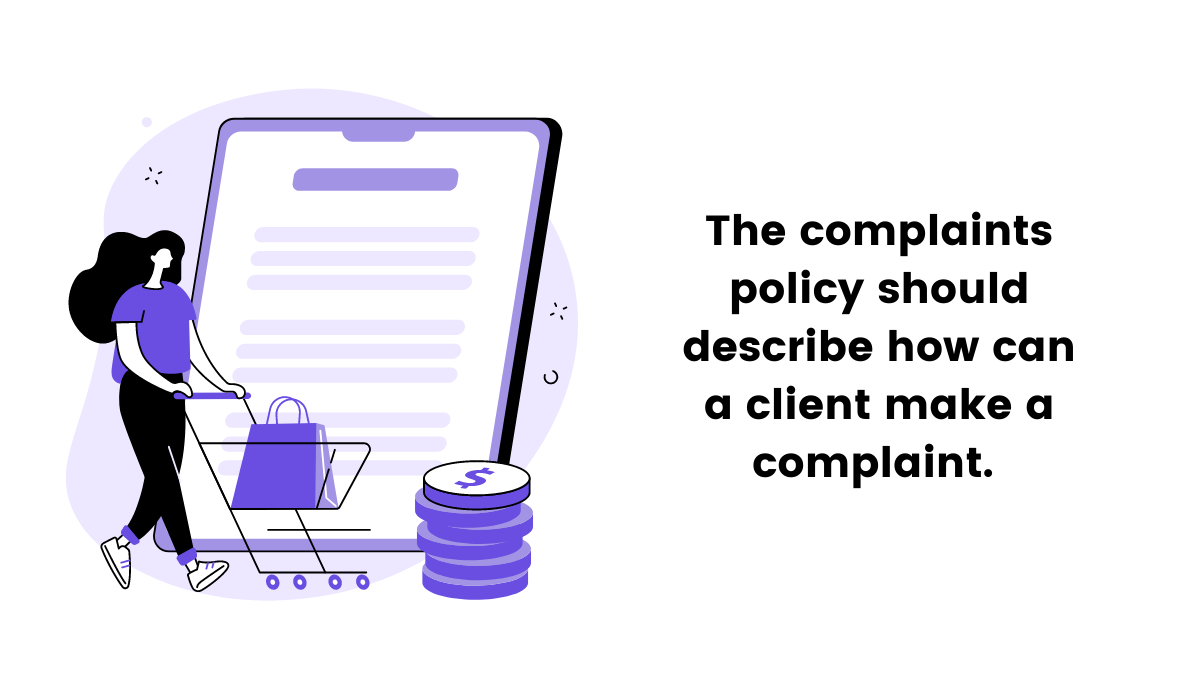
Source: Zoyya
Be it verbally, via email, or a letter, your clients should know you take the complaints seriously and want to resolve them in an official manner.
Having a written complaints policy also helps your staff because it enables them to resolve an issue when the manager isn’t at the salon.
Use Complaints to Improve
Getting a complaint or two doesn’t have to be the end of your business. You can take the complaints as examples of the kinds of issues your salon has to iron out so it can continue providing even better service.
In a SalonSense interview, Kristi Valenzuela, a salon team building coach, always advises thanking clients for their opinions, even if they are negative. She states that every complaint is a learning opportunity and a possible chance for improving your salon.
Here is what she suggests you say to an unhappy client:
“Thank you so much for bringing this to our attention. Your opinion and your thoughts of us are very important to the salon. We have a system for when clients are upset because our salon owner and our management always want to know what can make us better.”
Complaints also help you identify the training needs of your staff.
If you’re keeping records of your clients’ complaints, you’ll be able to detect areas for improvement.
You can go over them with your employees so they can get the complete picture of your salon, rather than focusing only on their expertise or station.
Remember, the customers’ needs change over time. Even if you provide exceptional services, you may still receive some complaints. Therefore, periodically going over clients’ complaints helps you gain insight into their needs and preferences.
Conclusion
You can’t change the fact that there will always be some clients who complain, but you can change how you approach the complaints.
If you welcome complaints with an open mind, you may even improve your business. The starting point is to acknowledge the client and listen to all valid complaints. When you diagnose a genuine reason for clients’ dissatisfaction, you can resolve the issue and get a loyal customer in doing so.
When handling client complaints, don’t forget about technology. You can use a digital solution to keep track of clients’ complaints. Remember to also deal with online complaints respectfully to show other clients you’re accountable for your work.
We hope our ten tips can help you make the complaint process a low-stress occurrence.
title: 6 Evergreen Tips on Client Communication For Cosmetologists description: Salon clients look for excellent service and a pleasant ambiance. We have 6 tips for client communication for cosmetologists to create a warm and welcoming atmosphere. category: resources language: en author: Nikolina imageUrl: /images/blog/client-communication-for-cosmetologists.jpeg date: 2021-11-17 status: PUBLISHED target: B2B
A cosmetologist’s primary job is to make their clients look beautiful. However, making them also feel beautiful is no less important. You can do that by adjusting the way you communicate in your salon.
Working in the beauty industry is demanding because you’re in direct contact with a wide variety of clients, all of whom have different personalities. It’s up to you to tailor your communication style for each client.
Don’t let this intimidate you.
In spite of their different preferences, there are some universal truths that will always make your clients feel welcome and comfortable.
This post will walk you through 6 communication tips you can start applying today.
Always Greet Your Clients Warmly
Greeting clients is Customer Relationship Management 101.
Experienced cosmetologists always teach apprentices how to greet the clients because this one simple act can set the tone for the whole appointment and further relationship.
Client communication is different for beauticians than for those working in financial services or law. Unlike the latter, in the beauty industry, you can and should be personal with your clients.
In fact, they expect that.
In light of this, more than a third of regular customers expect you to address them by their first name when they arrive at your establishment.
Personalized greetings and comments have an even more significant impact, with almost 50% of customers saying that these are contributors to an excellent customer experience.

Source: Zoyya
The way you greet your clients also matters.
It is best to do so immediately upon arrival, making sure your tone is warm and welcoming.
Clients will definitely appreciate your effort. They may even mention it in their reviews, which will possibly attract some new clients to your salon.
The following picture shows the testimonies of satisfied clients of a nail salon who especially appreciated a warm welcome.

Source: Google
Of course, clients look for excellent service first and foremost, but supplementing that with a welcoming attitude towards your clients will make an even greater impression.
Some service providers object to the idea of warmly greeting all customers, claiming that some clients simply don’t want attention.
Luckily, that’s mostly a myth; almost everyone likes their presence acknowledged.
You don’t have to be pushy with the greetings; just use them for starting a conversation and making your clients feel comfortable.
Take a Genuine Interest in Your Clients
Mindless chatter that serves simply to fill the silence is a regular occurrence in beauty salons.
But taking genuine interest in your clients is what does wonders for your relationship with them.
Some chatting is expected in beauty salons. If you already have a habit of talking to your clients, you can work on your listening skills and enhance their experience.
You can do more than chit-chat about the weather to make your client relaxed.
Let them lead the conversation to the topics both you and they feel comfortable with, and do your best to listen to them with interest.
Other than relaxing your client, genuine conversation strengthens your relationship with them, which in turn improves their perception of you and your cosmetology skills.
However, it’s hard to listen actively if you’re focused solely on thinking of a response. Since your relationship with the client is at the heart of your business, rather focus on what they’re saying.
You don’t have to have an answer to all of life’s questions, and your clients (hopefully) don’t expect you to, either.
Still, what you can do is engage in a meaningful conversation when you sense it’s appropriate.
Remember, the quality of service a salon provides is not the sole determining factor of how clients choose where to go.
Clients want to feel comfortable while they’re receiving treatments, so, besides friendly conversations, they also appreciate a pleasant ambience.
To make sure you provide a great atmosphere in your salon, you could go for some non-traditional methods, such as offering drinks, as this nail salon does:

Source: Instagram
You can further upgrade the atmosphere in your salon by selecting furniture and light fixtures carefully, using the right colors and textures.
If you combine a nice ambience with taking interest in your client, the chance of that client returning will skyrocket.
Keep the Conversation Professional
As a cosmetologist, you are a professional in a salon setting.
This means it’s your responsibility to redirect the conversation if you notice it’s straying to inappropriate topics.
There is no universal formula for conversations with clients.
Not only does the etiquette depend on the industry, but it is also shaped by the preferences of individual clients.
Some clients feel comfortable sharing their entire medical history, while some are rather private and prefer talking about more general topics, unrelated to their lives.
You’ll likely meet both kinds of clients, so you have to use your own judgment to decide what’s appropriate.
Still, some topics are best avoided altogether, such as politics, religion, or finances.
It’s worth noting that even if a client wants to discuss politics or religion, you have to be mindful of the other guests in the salon.
Some of them may be uncomfortable listening to such conversations, so you should consider steering the conversation away to something more neutral.
On the other hand, the items from our dos list are generally safe conversation starters.
Who doesn’t like at least a bit of celebrity gossip?
It’s also always a good idea to talk about the different nail, lash or brow upkeep techniques, depending on the treatment you’re providing at that moment.
All in all, with the exception of the three no-go areas we’ve mentioned above, a good rule of thumb is to go with the topics that the client initiates.
Let the client talk, but be there to moderate the conversation.
Learn the Little Details About the Client
If you’re a detail-oriented cosmetologist, you’ll undoubtedly be able to apply the same principle to client communication and learn the little tidbits about the client that will let them know you care.
That individualized approach will make them feel special.
A customer likes it when you treat them as an individual rather than seeing them as just another face in the crowd.
A survey on retail personalization found that more than half of all customers will become repeat buyers after a personalized shopping experience.
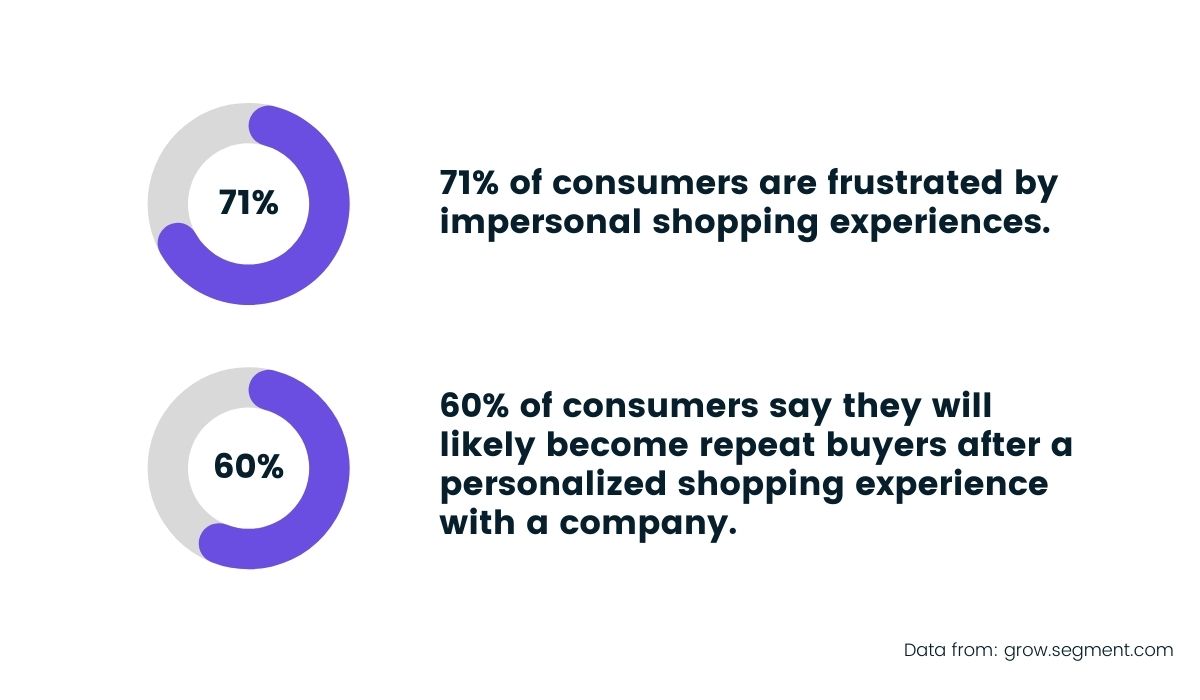
Source: Zoyya
Naturally, clients expect more familiarity when they visit beauty salons than they do in large department stores.
Salons operate on a one-on-one principle, so there are grounds for expecting higher levels of personalization.
As mentioned earlier, one thing you can do to provide that personal touch is remembering small details about your clients they don’t expect you to remember.
These details can be various, such as:
- The last treatment they got at your salon
- Treatment preferences
- Allergies or sensitivity to products
- Personal anecdotes they’ve told you about
They would also probably be glad if you remembered unrelated details such as their pets’ names.
But if a dozen clients walk through your salon every day, the details about them will certainly get mixed up.
That doesn’t mean you should resort to looking your clients up on social media–that’s a no-go.
Yet, there is a way you can use technology to help you with client communication.
By choosing a good client management solution, you can create a client base where you can keep records of their preferences.
For instance, Zoyya, our booking app, has a field for writing down details about any client in the database.
Here’s what it looks like:

Source: Zoyya
After the session with a client, you can write down anything that stands out, such as just started a small business or passionate about skydiving, and use them to enrich the conversation in the following sessions.
Zoyya also offers you an overview of the client’s previous appointments; that’s another treasure trove of conversation starters.
So, which aftercare steps did you take for the lash lift you got last month?
Personalized questions let your clients know you remember them.
Forget questions about the weather; use technology to aid you in client communication!
Speaking of a personalized approach in salons, you can learn how one of our clients makes an individual approach to each customer the cornerstone of her salon’s business philosophy here.
Know When Not to Talk
Knowing how to talk with your clients is as important as knowing when to talk.
To keep your clients comfortable, you also have to recognize it when they don’t feel like talking.
When clients book an appointment, they look forward to spending quality time being pampered.
For some, that may include catching up with their favorite cosmetologist while they’re getting their nails done, but some customers prefer being left with their own thoughts and enjoying the treatment.
Clients may like silence for various reasons. They may be too tired for conversation or may simply want to relax in silence. Some people just don’t like small talk.
We’ve listed some other reasons in the following picture:
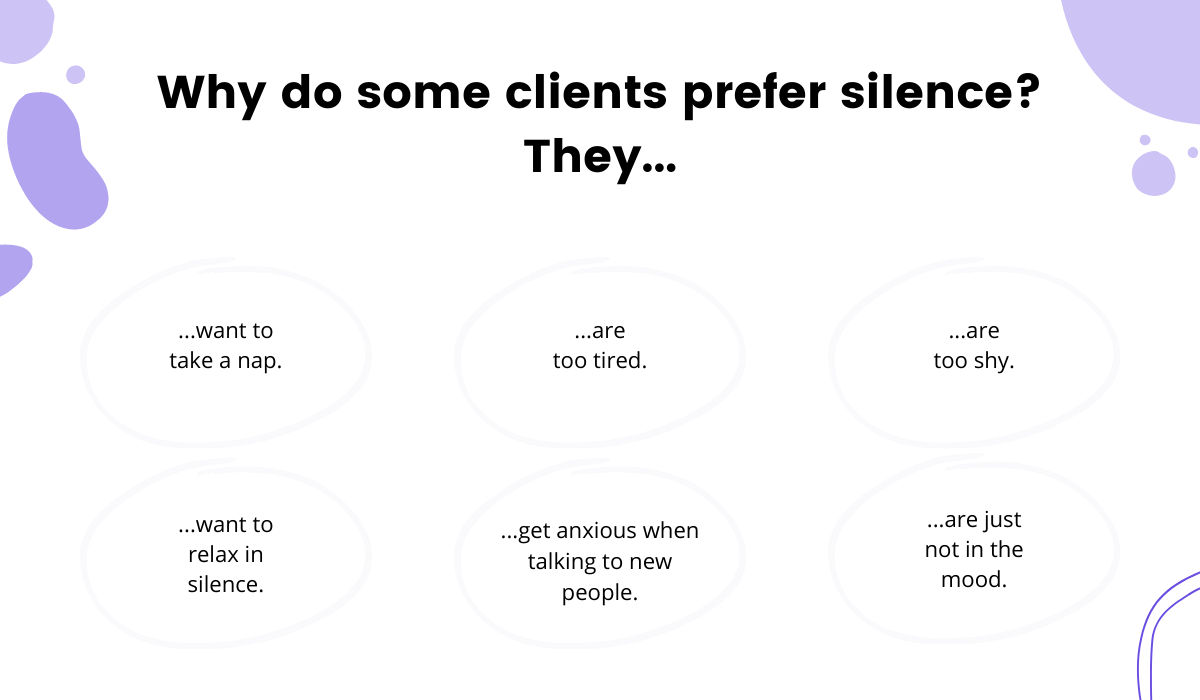
Source: Zoyya
One of the reasons we’ve mentioned in the picture was clients being shy or anxious. This is where you have to come through with your cosmetologist communication skills.
Observe your clients’ reactions and body language, and be empathetic.
If you notice they’re being terse with their answers or that they look tired, you should let them enjoy the treatment without talking.
The beauty industry is constantly evolving. Faced with an increasing number of clients expressing a preference for being left in peace, a London salon recently made news when they introduced the concept of the quiet chair.
The quiet chair is nothing more than a free, optional add-in that clients can select when making an appointment which means that, when they arrive at the salon, the staff only asks them questions necessary for the treatment.
Your clients can ask for a similar approach, even without an official quiet chair launch.
To make communication easier for clients, you should use a booking system that allows notes and comments in the booking process.
Take a look at how we do it:

Source: Zoyya
Using our booking system, clients can easily state their preferences. This helps you create the most comfortable environment possible for each client.
Be Aware of Your Non-Verbal Signals
Client communication for cosmetologists covers more than words. To achieve a good rapport with your clients, you should also be mindful of the non-verbal signals you send.
There was a myth stemming from a misinterpreted 1960s research stating that 93% of communication is non-verbal.
While such a high percentage has been debunked, it’s still true that non-verbal cues account for a significant part of communication.
So, what does non-verbal communication consist of?
Here are some commonly listed elements:
- Facial expressions
- Gestures
- The tone of your voice
- Volume
- Proximity
- Eye contact
Let’s see how non-verbal communication works in practice, in a salon environment.
Non-verbal communication starts as soon as clients enter the salon, so you should stand up when greeting them.
Next, a frequent mistake is keeping barriers between you and your clients. That’s something you should avoid.
Of course, you need a workstation to hold all your equipment while doing nails. But when a client comes for a consultation, you should remove all obstacles between you and the client and give them your full, undivided attention.
This also means that you should avoid talking while making eye contact with them in the mirror.
Remember how we mentioned you should express interest in your clients?
Well, there are non-verbal ways to do that as well.
You can find a quick overview of non-verbal cues that convey interest in the following picture.
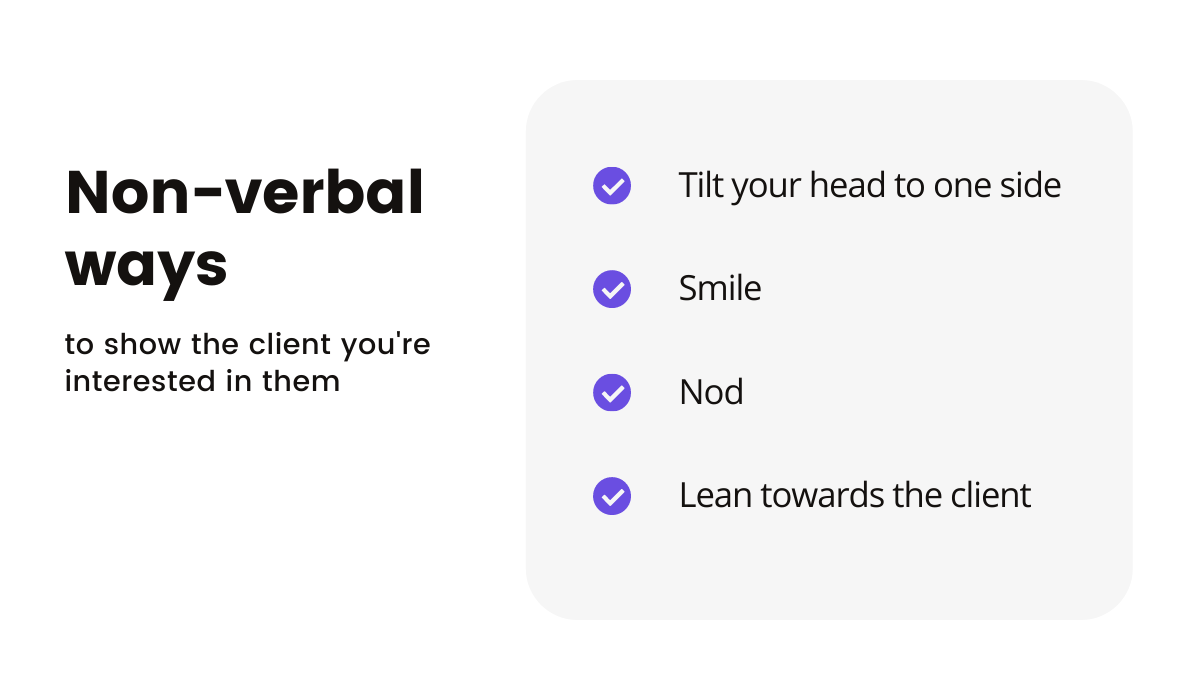
Source: Zoyya
When your client is telling you a story, you can show you’re interested in it by tilting your head or leaning towards them to hear better.
Nodding is a way to show you’re following. And a smile is always a welcome tool to make clients feel comfortable.
Don’t forget about the rest of your body, either.
Avoid crossing your arms, legs, and feet, as this makes you seem closed-off and guarded. You want to appear more open, so your clients can feel relaxed with you.
Conclusion
It’s the little details that can transform a good salon experience into an excellent one. Client communication is one of the areas where details in approach can enhance clients’ experience and improve their perception of your salon.
Even small actions, such as greeting your customers or remembering details about their previous treatments can make them feel cared for.
We hope these 6 tips will find their way into your salon so you can have many satisfied returning clients.
And don’t forget to lead by example!
If you are an expert communicator, let your employees follow your lead so you can create an amazing atmosphere in the entire salon.
#1 booking app
Schedule a demoSubscribe to our blog
We never send spam or share your email address.
